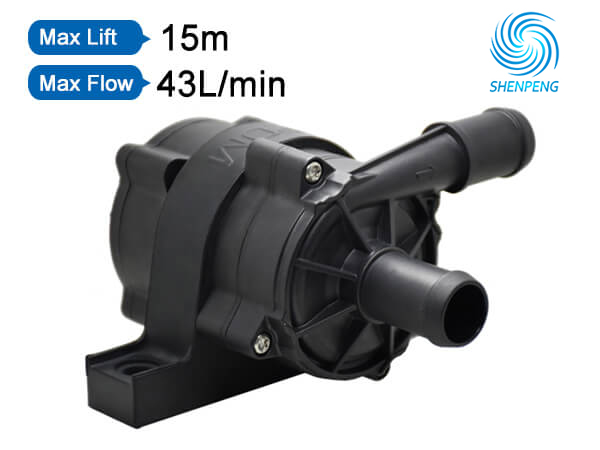The Critical Role of Automotive Electronic Water Pumps in New Energy Vehicle Battery Thermal Management
Published:2025-09-10

Amid the global wave of electrification in the automotive industry, new energy vehicles (NEVs) are rapidly gaining popularity due to their environmental benefits and high efficiency. As the core power source, the performance of power batteries directly determines driving range, safety, and service life. To ensure stable performance, the Battery Thermal Management System (BTMS) plays a vital role — and at the heart of this system lies the automotive electronic water pump, Specifically, the high-efficiency DC brushless electric water pump developed by Shenpeng Technology — including the P60 series, P80 series, and P90 series — plays a critical role in NEV battery thermal management.. Through precise fluid control, this advanced component supports breakthroughs in NEV performance and reliability.
1. Battery Thermal Management: The Foundation of NEV Performance
The electrochemical properties of power batteries are highly sensitive to temperature, with an optimal operating range of 25–40°C.
- Low temperature risks: Below 0°C, battery capacity decreases by 20%–30%, charging efficiency drops sharply, and lithium dendrite precipitation may occur.
- High temperature risks: Above 55°C, internal side reactions accelerate, cycle life shortens drastically, and thermal runaway accidents may occur. Research shows that every 10°C rise reduces cycle life by up to 50%.
To prevent localized overheating or cooling, an efficient BTMS must maintain the battery pack temperature difference within ±5°C across all conditions — including charging, discharging, and standby.
As ternary lithium batteries with energy densities exceeding 300Wh/kg and emerging solid-state batteries generate 40% more heat than traditional ones, BTMS design faces tougher demands. In addition, the rise of 800V fast charging technology increases instantaneous heat generation by 60%, requiring more advanced dynamic thermal management solutions.
2. How Automotive Electronic Water Pumps Work in BTMS
The DC brushless automotive electronic water pump provides the driving force for coolant circulation within the battery pack. It operates in two primary modes:
(1) High-Efficiency Cooling Mode
When the battery temperature rises beyond its safe range, the water pump drives coolant through liquid-cooled plates at 1500–4000 rpm. These micro-channel plates, tightly attached to battery cells, transfer heat to external exchangers via forced convection. Under peak discharge, the pump must maintain a stable flow of 5–12 L/min to keep the cell surface temperature difference within 3°C — a critical requirement for high-power output and fast charging.
(2) Intelligent Heating Mode
In cold climates (e.g., -20°C), the water pump cooperates with electric heaters (PTC or waste heat recovery systems) to preheat the battery. By circulating coolant at low speed (800–1500 rpm), it warms the pack quickly, then switches to a large-cycle circulation once the battery reaches 5°C. This strategy reduces preheating time by 30% and energy consumption by 35%, solving the challenge of low-temperature performance loss.
(3) Advantages of Brushless Motor Technology
Unlike traditional mechanical pumps, DC brushless electronic water pumps use neodymium-iron-boron permanent magnets and Hall sensors to achieve motor efficiency above 90% (vs. ~65% for conventional pumps). With an IP67 waterproof design and brushless structure, service life exceeds 20,000 hours, ensuring long-term reliability for NEVs.
3. Precision Control: Creating a Dynamic Thermal Balance
(1) Multi-Sensor Fusion for Intelligent Control
Shenpeng’s automotive electronic water pump integrates temperature (±0.5°C), flow (0.1 L/min resolution), and pressure (0–1 MPa) sensors. These collect real-time data on coolant performance and communicate with the Vehicle Control Unit (VCU) via CAN bus. Using a fuzzy PID algorithm, the pump dynamically adjusts speed to deliver on-demand cooling or heating.
For example, under NEDC conditions, pump energy consumption is only 1.2%–1.8% of total vehicle energy, 40% lower than fixed-speed pumps — improving overall efficiency.
(2) Optimized Flow Channel Design
By applying CFD simulations, Shenpeng Technology optimizes internal flow channels to reduce resistance and enhance coolant circulation. This ensures stable flow in complex battery pack layouts and prevents heat dissipation losses caused by poor fluid dynamics.
4. Why Automotive Electronic Water Pumps Are Essential for NEVs
With the dual challenges of range anxiety and safety assurance, battery thermal management has become a cornerstone of NEV design. The automotive electronic water pump is the core component that enables precise thermal regulation, efficient energy conversion, and intelligent system collaboration.
Shenpeng Technology’s DC brushless water pump combines:
- High reliability with over 20,000 hours of service life.
- Advanced intelligent control based on multi-sensor fusion.
- Optimized hydraulic design for stable performance under real-world conditions.
For automakers, partnering with a supplier that has mature technology and proven application experience in automotive electronic water pumps is crucial to enhancing NEV performance, safety, and customer trust.
- Distribution in Water Heater Mattresses: Why BLDC Pumps Ensure Uniform Heating
- How BLDC Pumps Ensure Precise Flow in Water Dispensers
- Why BLDC Pumps Are Essential for Smart Toilets
- The Critical Role of Automotive Electronic Water Pumps in New Energy Vehicle Battery Thermal Management
- Noise Control Technology for Smart Toilet Water Pumps: Enhancing Quiet Operation in Modern Bathrooms
- Unveiling the Working Principle of Automotive Electronic Water Valves
- Comparative Analysis of Liquid-Cooled Pumps vs. Air-Cooled Systems for EV Charging Stations
- Technical Application of Brushless DC Motors in Energy Storage Circulation Pumps
- Water Heater Pump: Efficiency Upgrade for Low-Voltage Systems
- How Dishwasher Water Pumps Enhance Cleaning Coverage Through Stable Operation?
